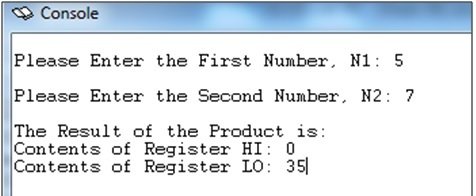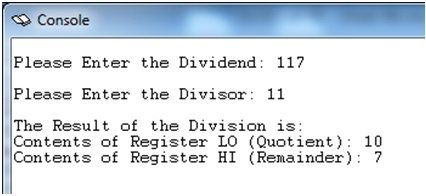What Does It Mean If The Hi Register Is -1 Mips
Integer Multiplication in the MIPS Assembly Language
The generic form of the mult (signed integer multiplication) and multu (unsigned integer multiplication) instructions is:
Signed Integer Multiplication: mult $Rs, $Rt
Unsigned Integer Multiplication: multu $Rs, $Rt
mult and multu belong to the Arithmetic Cadre Instruction Set and are R-type instructions where $Rd, the destination annals, does non announced. So where does the effect become? The result automatically goes into 2 special registers chosen HI and LO.
The semantics are given below:
(HI, LO) = Rs * Rt
We know that multiplying the contents of ii 32-bit registers will give a 64-scrap result. The high 32 bits are placed in a register chosen Hello. The low 32 bits are placed in a register called LO. You lot just need to read LO if you lot know your result fits into the Lower 32-bits.
To access the Hello and LO registers, which are 2 additional registers beyond the 32 integer registers and are specifically used for integer multiplication and division, nosotros utilise the following instructions:
mfhi $Rd for example, mfhi $a0
mflo $Rd
mfhi ways "move from HI" to the destination annals. mflo means "move from LO" to the destination annals .
Do-1 : Write a code that reads two numbers and returns their product:
Your program should enquire the user to enter two integer numbers at the PCSPIM console window. It should read these numbers and perform their integer multiplication. The result of the product should also be printed at the console of PCSPIM. For now, perform this multiplication for such numbers that the result is accommodated in 32-$.25 and thus fits into LO. However, impress the contents of both HI and LO on the console. We have given the .data segment of the lawmaking beneath. Fill in the blanks in the data segment and develop your code in the text segment accordingly.
Code :
.data Number1: .asciiz "\nPlease Enter the First Number, N1: " Number2: .asciiz "\nPlease Enter the Second Number, N2: " Consequence: .asciiz "\nThe Upshot of the Product is: " High: .asciiz "\nContents of Annals Hello: " Low: .asciiz "\nContents of Register LO: " .text .globl main main: (Write the rest of the lawmaking below) li $v0, 4 la $a0, Number1 syscall li $v0, v syscall add $t0, $v0, $zilch li $v0, 4 la $a0, Number2 syscall li $v0, 5 syscall add $t1, $v0, $zero mult $t0, $t1 li $v0, iv la $a0, Issue syscall li $v0, 4 la $a0, High syscall li $v0, i mfhi $a0 syscall li $v0, 4 la $a0, Low syscall li $v0, i mflo $a0 syscall End_Prog: li $v0, 10 syscall
Figure one: Example of how the console window should look similar after the execution of your program in Do-1
Integer Sectionalisation in the MIPS Assembly Language
The generic class of the div (signed integer sectionalisation) and divu (unsigned integer partition) instructions is:
Signed Integer Sectionalisation: div $Rs, $Rt
Unsigned Integer Sectionalization: divu $Rs, $Rt
div and divu belong to the Arithmetics Core Education Set and are R-type instructions where $Rd, the destination register, does not announced. The registers Hi and LO are used here as well
The semantics are given below:
LO = Quotient of (Rs ÷ Rt)
HI = Residue of (Rs ÷ Rt)
As in Task-1, the instructions mfhi and mflo will be used to re-create the contents of the registers HI and LO respectively into some destination register Rd.
mfhi $Rd for example, mfhi $a0
mflo $Rd
mfhi means "move from HI" to the destination register. mflo means "move from LO" to the destination register.
Practise-ii : Write a code that reads two numbers and performs division:
Your program should enquire the user to input two integer numbers at the PCSPIM panel window, ane of them beingness the dividend and the other being the divisor. Information technology should and so perform the necessary partition. The result of the sectionalisation should also be printed at the console of PCSPIM in terms of Quotient and Residue. We take given the .information segment of the lawmaking below. Make full in the blanks in the data segment and develop your code in the text segment appropriately.
Lawmaking:
.data Dividend: .asciiz "\nPlease Enter the Dividend: " Divisor: .asciiz "\nPlease Enter the Divisor: " Consequence: .asciiz "\nThe Result of the Division is: " Quotient: .asciiz "\nContents of Register LO (Quotient): " Remainder: .asciiz "\nContents of Register HI (Residue): " .text .globl master main: #(Lawmaking non required in the actual Lab-5 Submission) li $v0, 4 la $a0, Dividend syscall li $v0, 5 syscall add together $t0, $v0, $zero li $v0, 4 la $a0, Divisor syscall li $v0, 5 syscall add $t1, $v0, $zero div $t0, $t1 li $v0, iv la $a0, Result syscall li $v0, four la $a0, Quotient syscall li $v0, 1 mflo $a0 syscall li $v0, iv la $a0, Remainder syscall li $v0, 1 mfhi $a0 syscall End_Prog: li $v0, 10 syscall
Figure 2: Example of how the console window should look like after the execution of your program in Exercise-2

What Does It Mean If The Hi Register Is -1 Mips,
Source: https://microcontrollerslab.com/multiplication-division-mips-assembly-language/
Posted by: sampsontherond.blogspot.com


0 Response to "What Does It Mean If The Hi Register Is -1 Mips"
Post a Comment